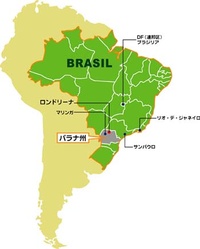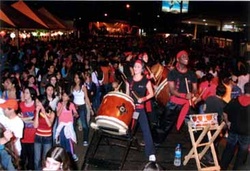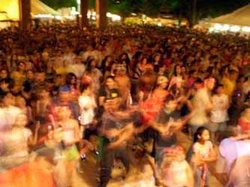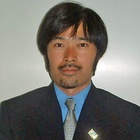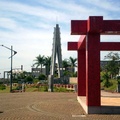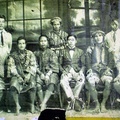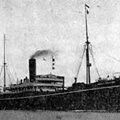Recently in Brazil, terms such as “Nikkei culture” and “Shin (new) Nikkei culture” have become popular to use, especially among the Japanese-language papers. These terms are used to describe a “culture based upon ‘Japanese culture’ with a Brazilian-style influence.” This shows that there is a conscious differentiation between the “Japanese culture of Japan” and the “Japanese culture of Brazil,” defining the latter as a “Nikkei culture” that is a part of the multicultural “Brazilian culture.”
Currently, the area that is seeing the most intense presence of this Nikkei culture is North Paraná (the northern area of the state of Paraná). Heavily occupied by Nikkei farmers since before the war, the region has seen remarkable Nikkei activity with its involvement in politics, finance, law, and business in the postwar era. The central metropolis of North Paraná, Londrina (with a population of about 500,000), was developed in the pre-war era by a company in England, and thus was named after London (see: Map 1). Nikkei immigration began in pre-war 1930, and today there are already Sansei and Yonsei generations. Moreover, this city is the sister city of Nishinomiya, Hyōgo prefecture, so there exists a strongly integrated Nikkei community.
One of the highlights within the Nikkei culture in Lodrina is the “Matsuri Dance.” Held at the Londrina Matsuri every September, the Matsuri Dance is a creative interpretation of Japanese Bon Odori, introduced around 15 years ago as “Bon'odori Novo” (new Bon Odori) in this region.
Based on the basic choreography of Bon Odori, the Matsuri Dance adds movements from pop and street dance, all uniquely arranged with different genres and rhythms of Japanese pop music like “Matsumoto Bonbon,” “Shimauta,” “Gizagiza Haato No Komoriuta,” and “Runner.” On a stage equipped with a mikoshi, men and women sing along with live music while taiko drummers and dancers enliven the show.
The Londrina Matsuri is an event that began in 2003, and since then it has been held every September in the city at Nishinomiya Park. The organizing group, which we’ll introduce in detail later, is Grupo Sansey—a group led by Nikkei musician Miriam Michiko Shiroma. In a 19,000 square meter area, there are stands for Japanese foods and drinks including yakisoba and maki-zushi, stands selling traditional Japanese crafts, and play areas for children and families to enjoy the weekend together. In 2007, thanks to a string of good weather, 150,000 people visited the event within a four-day period. On stage, there were presentations including a karaoke show, taiko drumming, Okinawan dancing, Yosakoi Soran, and other local and traditional dance performances. There was also a special area where the Nagashi Somen experience drew attention. The biggest attraction, however, is the nightly performance of the Matsuri Dance.
The leaders of Grupo Sansey, Mr. and Mrs. Louis and Michiko Shiroma, and one of the founding members, Claudio Furukawa, explained to me about the allure and history of the creation of Matsuri Dance: In 1988, Michiko, who taught karaoke, felt that something was missing in singing Japanese with a Japanese melody. That year, they happened to be celebrating the 80th anniversary of Japanese immigration to Brazil, and celebratory events were to take place throughout Brazil, centered in São Paulo. There were, of course, events in Nikkei-concentrated Londrina, but most of the staff members organizing the event were Issei. The planning of the event was mostly based upon their initiatives, so it was a difficult task to have them consider the ideas of the younger generation, including Michiko.
“The Issei were always saying that we don’t speak proper Japanese, or that we need to have more Japanese pride; but we’re Brazilians, born and raised in Brazil… It’s fine for our grandparents to have their own way of doing things, but we should also be allowed to have our own way of doing things. ‘Japanese Culture’ isn’t just one-dimensional.” Emphasizing the diversity of Japanese culture, Michiko and her friends wanted to commemorate the 80 years of immigration in a different style from that of the Issei—something different than of her grandparents’ generation. Based on this idea, in 1988 she founded Grupo Sansey together with the younger members of her karaoke class. This group was registered as a nonprofit organization in 1994, under the name Grupo Sansey, Cultural e Beneficente (Sansei Group, Cultural and Charity). In 2003, they successfully organized and held the first Londrina Matsuri. The three founders all mentioned in agreement that watching 12,000 people dancing the Matsuri Dance in unison one night was an unforgettable moment.
“We had an identity of being ‘Japanese’, but wanted to show that it was different from being ‘Issei’,” says Michiko. “With the festival we wanted to show that we, the Nikkei, had welcomed the Japanese culture, and that the seeds that our grandparents sowed had yielded good fruit. In addition, we wanted to introduce Japanese culture to the non-Nikkei Brazilians, and to create a new type of Brazilian culture.” The name “Grupo Sansey” has a double meaning—one being Nikkei Sansei, as in the 3rd generation Brazilian-Japanese, and the other a Japanese term for affirmation (sansei, meaning “approval”).
In November 2006, the Matsuri Dance made its debut in São Paulo. At an event called “Japan Experience – Experimientando a cultura Japonesa 06”—an event focused on introducing Japanese culture to the public—the young Nikkei Sansei Group members from Londrina came and danced the Matsuri Dance together with the event goers. This signified the moment when the Matsuri Dance could no longer be contained as only a local tradition in the Northern Paraná Nikkei community.
2008 will mark the 100th anniversary of the arrival of Japanese immigrants to Brazil, who first came aboard the Kasato Maru. Today, the “Japanese culture” exists in society as “Nikkei culture,” and is now recognized as a movement with a new meaning and position. As Michiko mentioned, it positions itself to factor in attractively as a part of the “New Brazilin Culture,” which is becoming dynamically multicultural. The Matsuri Dance reflects the current progression in the path towards the creation of this new culture.
Returning to the 2007 Londrina Matsuri—on the last day, September 9th, the Matsuri Dance had started at 8pm and reached its climax with 15,000 people dancing in unison. With each announcement of a new song and choreography for the dance, cheers could be heard from all over the place. The dancers comprised of not only the youth, but also groups of middle-aged women were prevalent as well. Nikkei and non-Nikkei alike, regardless of the color of their skin, danced together enthusiastically. I was very impressed to see that, in a city almost completely unknown to the Japanese people, located on the other side of the world, a Nikkei group was able to put together such an intense, multi-ethnic atmosphere.
Reference:
Grupo Sansey—http://www.gruposansey.org.br
© 2008 Sachio Negawa


